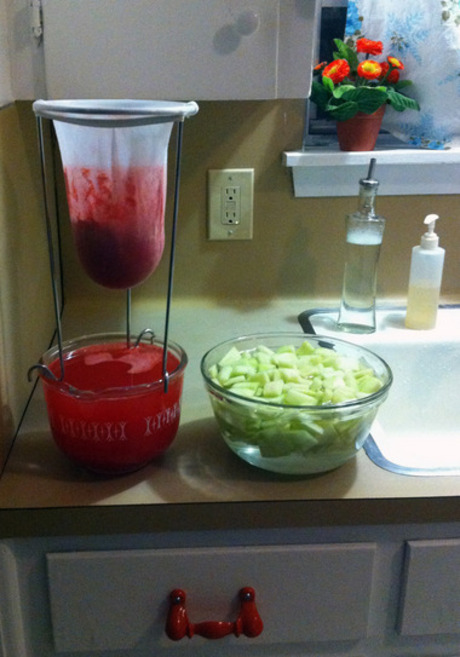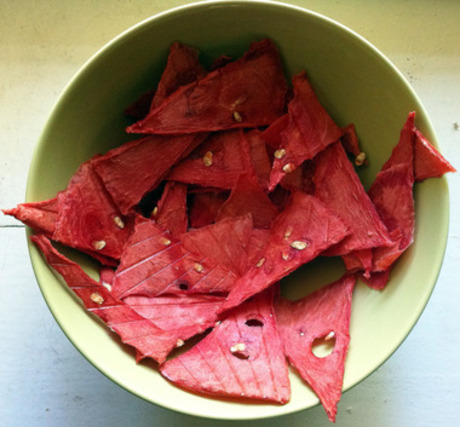Preserving watermelon
Put up watermelon three ways.
1. Gingery pickled rinds
If anyone ever gives you a jar of watermelon rind pickles, know that they love you a lot. Extracting the white, edible portion of rind from beneath its darker green facade is a royal pain in the ass. Now that I’ve done it twice I can safely make that bold claim. I used Linda Ziedrich’s Gingery Watermelon Rind Pickles recipe from her Joy of Pickling book, which I’m actually giving away right now. Since I didn’t change it in the slightest, please borrow from a friend, check out from the library or purchase (if you can) a copy of Linda’s book. (July 2013 Update: I’ve rewritten, but not modified ingredients for Linda’s recipe, you can now see it here)
I made this recipe last year just before leaving for our Fire Island vacation. It’s cool to see the memories that pop out unexpectedly when I’m tackling seasonal foods each year. In this case, I remember discovering how slow-going rind extraction is and butting up against pre-vacation time constraints with the 12-hour brining instructions and wishing I’d read the recipe more thoroughly before starting such a venture. [I was up late the night before we left and using my canner pot up until an hour before we wheeled half our house over to the Long Island Railroad.]
Anyhow, this year all went according to plan, except that I ran out of syrup when putting the pickles in jars. I improvised (out of not having time before leaving for book tour travels to infuse the spice mix into another vinegar/water/sugar syrup) and boiled a half white wine vinegar, half water plus some sugar and salt brine I had leftover from my rhubarb pickling experiment last month. We’ll have to wait and see how those less-spiced rind pickles turn out!
2. Jelly and/or Syrup
One thing is pretty standard about working with watermelon; there’s always more of it than you expected once you get in there and start chopping things up.
I had enough strained juice for two batches of jelly. This of course meant one attempt straight-up from a published recipe and another attempt using my apple pectin stock and a few underripe blueberries, thrown in for good measure.
For the added-pectin attempt, I followed Sherri Brooks Vinton’s recipe in Put ‘em Up for Heirloom Watermelon Jelly, which uses Pomona’s Universal Pectin. I think next time I’ll go with the advice on Pomona’s packaging; they suggest making a tiny test batch to make sure the ratio of calcium water to pectin in the sugar makes the consistency you’re most happy with. The set achieved by following this recipe turned out a bit too firm for my liking. I consider it a fine opportunity to do some further Pomona’s experimentation. (Same deal goes for the recipe here; I didn’t alter it at all so look it up in her book or find another recipe for watermelon jelly online.)
The apple pectin stock version turned out to be an excellent watermelon syrup. Perfect for adding to club soda and/or vodka. A fizzy version of summer in a cup!
Watermelon Syrup, fridge storage
yields a little more than a pint jar
1. Combine and place covered in the fridge overnight:
4 cups strained watermelon juice (I chopped, food-processed, and then strained the pulp in my jelly bag to make juice.)
2 cups sugar
2 Tbs lemon juice
2. The next day add 3/4 cup apple pectin stock (see link above for instructions) and a handful of underripe berries of some sort if you’ve got ‘em. I placed the berries in a muslin spice/tea bag.
If you don’t have the berries or the pectin stock, use unsweetened apple juice or frozen juice concentrate or just skip it altogether since the only reason it’s in there was to achieve a possible jelly set.* (Next time I tackle a watermelon I’ll probably tweak this syrup recipe to omit this step, but the syrup I ended up with tasted great, these ingredients included.)
 Using underripe berries can help add some pectin oomph to your jelly3. Bring the mixture to a simmer to dissolve any remaining sugar granules. And then raise heat to med-high and boil for 10 minutes, stirring occasionally to keep sugar from scorching the bottom of your pan. Remove from heat and let it sit for 5 minutes before ladling it into a clean, hot jar.
Using underripe berries can help add some pectin oomph to your jelly3. Bring the mixture to a simmer to dissolve any remaining sugar granules. And then raise heat to med-high and boil for 10 minutes, stirring occasionally to keep sugar from scorching the bottom of your pan. Remove from heat and let it sit for 5 minutes before ladling it into a clean, hot jar.
Let sit on counter to cool for an hour or so and then keep this in the fridge because watermelon is a low-acid food and this syrup recipe is not written/tested for safe shelf storage.
*I realized once it was simmering that, since the watermelon juice is primarily water and contains hardly any pectin in the fibers remaining in the skimmed juice, I was cooking and skimming all the red and flavor out. Making non-added-pectin jelly with watermelon (and retaining watermelon flavor) wasn’t going to happen, so I hopped ship and made syrup before I’d lost all watermelon flavor entirely.
3. Dried watermelon
Many thanks go out to a hip Facebook page follower, Reena, who gave me the idea to dehydrate some of the endless red interior. [You can only eat so much watermelon at 9pm, a funny predicament to be in when usually what people go for when they pick up a watermelon is the red deliciousness.]
I sliced a quarter of the melon into 1/4”-strips or thinner if you can and then cut off the crescent-shaped rind portion from those slices and then made watermelon chips about the size of regular tortilla chips.
My Nesco dehydrator has a setting for fruit, which is 135 degrees F. I plugged it in and let it go overnight (~8-12 hours) and voila! A perfectly textured Jolly Rancher fruit leather!
You could make these with alternative methods of dehydration (oven, sun, etc.), but I don’t have tips for dehydrated watermelon via those methods since I used my (beloved) machine. Let me know how it goes for you if you try it another way.
Happy summer my friends; don’t forget to use the most fun part of the watermelon: challenge someone to a seed-spitting contest!
Since posting this, I’ve seen a number of exciting other watermelon usage ideas. Here’s a round-up:
- Pickled, unripe watermelons [recipe and description to come from a reader]
- Stick a spigot in your melon and use it as a drink dispenser, a brilliant post from Austin’s Addie Broyles

